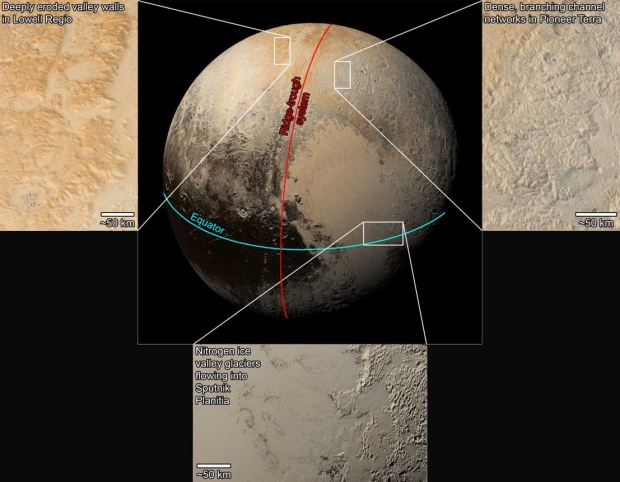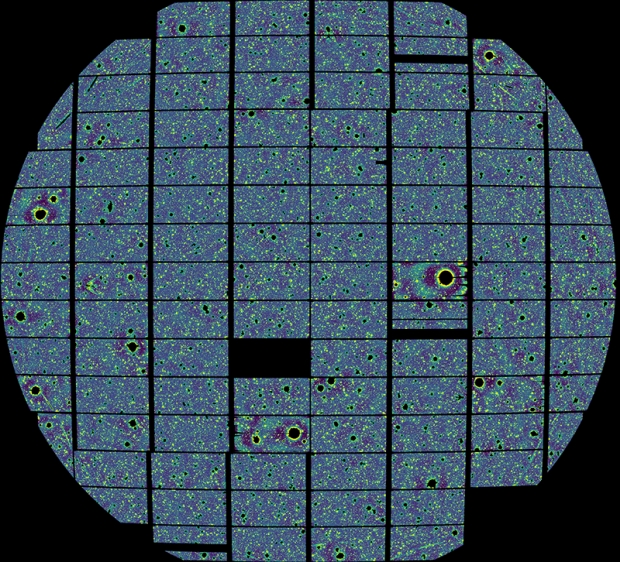At
3.15.23
Paul Gilster


New Horizons is, like the two Voyagers, a gift that keeps on giving, even as it moves through the Kuiper Belt in year 17 of its mission.

Thus the presentations that members of the spacecraft team made on March 14 at the 54th Lunar and Planetary Science Conference. Papers will flow out of these observations, including interpretations of the twelve mounds on the larger lobe of Arrokoth, the contact binary that is being intensely studied through stereo imaging to identify how these features formed around a larger center mound. Alan Stern (SwRI) is principal investigator for the New Horizons mission:
“We discovered that the mounds are similar in many respects, including their sizes, reflectivities and colors. We believe the mounds were likely individual components that existed before the assembly of Arrokoth, indicating that like-sized bodies were formed as precursors to Arrokoth itself. This is surprising, and a new piece in the puzzle of how planetesimals – building blocks of the planets, like Arrokoth and other Kuiper Belt objects come together.”
Science team members also discussed the so-called ‘bladed terrain,’ evidently the product of methane ice, that seems to stretch across large areas of Pluto’s ‘far side,’ as observed during the spacecraft’s approach. It was intriguing to learn as well about the spacecraft’s observations of Uranus and Neptune, which will complement Voyager imaging at different geometries and longer wavelengths. And Pluto’s ‘true polar wander’ (the tilt of a planet with respect to its spin axis came into play (and yes, I do realize I’ve just referred to Pluto as a ‘planet’). Co-investigator Oliver White:
“We’re seeing signs of ancient landscapes that formed in places and in ways we can’t really explain in Pluto’s current orientation. We suggest the possibility is that they formed when Pluto was oriented differently in its early history, and were then moved to their current location by true polar wander.”

Pluto’s Sputnik Planitia, the huge impact basin found in Pluto’s ‘heart’ region, seems to have much to do with the world’s axial tilt, while the possibility of a deep ocean pushing against the basin from below has to be taken into account. This image is from the presentation by Oliver White (SETI Institute) at LPSC. Credit: James Tuttle Keane/ NASA/Johns Hopkins APL/SwRI/.
But let me pause today on the quest for other Kuiper Belt Objects as the search for a second flyby candidate continues. Not that a flyby is essential. Using the Japanese Subaru Telescope in Hawaii and the Victor M. Blanco instrument at Cerro Tololo, the team is now applying a deep learning algorithm (a ‘convolutional neural network’) to analyze imagery.




Wes Fraser, a member of the science team, is quoted on the New Horizons site as saying “The software network’s classification performance is extremely good, significantly cutting back on ‘false’ candidate sources. An entire night’s worth of search data requires only a few hours of human vetting. Compare that to the weeks it used to take to do this!”

A “stack” of images from one night of observing with the Subaru Telescope’s Hyper Suprime-Cam, showing myriad stars that illustrate the difficulty of spotting an undiscovered Kuiper Belt object.

The animation below shows movement – across the center-right of the frame — of a newly discovered KBO in one of these images. Credit: NASA/Johns Hopkins APL/Southwest Research Institute/Subaru Telescope.
This animation shows movement—across the center-right of the frame—of a newly discovered Kuiper Belt object in one of the Subaru Telescope Hyper Suprime-Cam images. Credit: NASA/Johns Hopkins APL/Southwest Research Institute/Subaru Telescope.
Will JHU/APL’s Interstellar Probe design eventually be approved and join the spacecraft now departing our Solar System? Or will JPL’s Solar Gravity Lens mission to the gravitational focus become our next deep space sojourner? As we ponder mission designs and the likelihood of their approval, keeping an eye on our existing assets in deep space reminds us of the outstanding science return we’ve achieved thus far.
See the full article here .
Comments are invited and will be appreciated, especially if the reader finds any errors which I can correct. Use “Reply”.
five-ways-keep-your-child-safe-school-shootings
Please help promote STEM in your local schools.
Tracking Research into Deep Space Exploration
Alpha Centauri and other nearby stars seem impossible destinations not just for manned missions but even for robotic probes like Cassini or Galileo. Nonetheless, serious work on propulsion, communications, long-life electronics and spacecraft autonomy continues at NASA, ESA and many other venues, some in academia, some in private industry. The goal of reaching the stars is a distant one and the work remains low-key, but fascinating ideas continue to emerge. This site will track current research. I’ll also throw in the occasional musing about the literary and cultural implications of interstellar flight.
 Centauris Alpha Beta Proxima, 27 February 2012. Skatebiker.
Centauris Alpha Beta Proxima, 27 February 2012. Skatebiker.

 National Aeronautics and Space Administration Galileo Spacecraft 1989-2003.
National Aeronautics and Space Administration Galileo Spacecraft 1989-2003.
Ultimately, the challenge may be as much philosophical as technological: to reassert the value of the long haul in a time of jittery short-term thinking.


